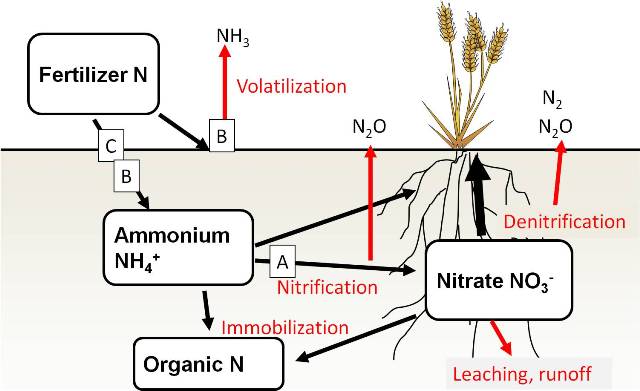This page is archived. The information has not been recently updated, but it can be used for research or reference purposes.
Enhanced Efficiency Additives for Nitrogen - How they Work
Prepared by John Heard, MB Ag Soil Fertility Specialist (FPE)
There has been an increase in the number of products now available for increasing the efficiency of applied nitrogen. The following is a review of the various products and their activity.
In Manitoba we traditionally presume the efficiency of nitrogen applied for crops is typically 40-60%. That means that 40-60% of the nitrogen is not taken up by the crop, some being lost permanently through volatilization, deep leaching and denitrification and some being temporarily tied up or immobilized by soil microbes to decompose straw. Conversely, crops are obtaining the remainder of their nitrogen needs elsewhere (residual soil N, mineralization of organic matter, manure and previous pulse crops, etc).
Additives or enhancers do not increase yields over traditional nitrogen products but under loss conditions they minimize those losses so more is available for the crop. There are 3 main types of enhanced efficiency products based on their activity.
- Nitrification inhibitors: delays the conversion of ammonia-form nitrogen (anhydrous ammonia, urea and the urea fraction of UAN solution) to the nitrate form which is vulnerable to leaching and denitrification. The NH4+ form has a positive charge and is held on the cation exchange complex which prevents any leaching.
- Urease inhibitors: delays the breakdown of the urea molecule (CO(NH2)2 ) into the ammonia form (NH3)by inhibiting activity of the urease enzyme. It is this free ammonia form that is vulnerable to volatilization loss from surface applications or causes seed-burn when seed-placed.
- Controlled release: Urea form N (CO(NH2)2 ) can be bound to molecules that are degraded slowly or enclosed within coatings. The most common is ESN urea (44-0-0), enclosed within a polymer coating that allows urea to diffuse out.
Soil nitrogen reactions are described in Figure 1 below, where those leading reactions to losses are labelled in red with red arrows. The points where these enhancers prevent loss are shown as the lettered box (A = nitrification inhibitor, B = urease inhibitor and C = controlled release) as described above.
Those products Manitoba growers are most likely to hear promoted are listed in Table 1 below.
Figure 1. Soil nitrogen reactions leading to nitrogen fertilizer losses (adapted from C. Grant)

Table 1. Enhanced nitrogen efficiency products and relative cost (winter 2011).
| Product | Active Ingredient | N Product | A. Nitrification inhibitor | B. Urease inhibitor | C. Controlled release | Relative cost if Urea $0.50/lb N |
| ESN | Polymer coating | Urea 44-0-0 | yes | $0.65/lb N | ||
| Agrotain | NBPT | Urea 46-0-0, UAN 28-0-0 |
yes | $0.57/lb N | ||
| SuperU | NBPT and DCD | Urea 46-0-0 | yes | yes | $0.62-$0.65/lb N | |
| Agrotain Plus | NBPT and DCD | UAN 28-0-0 | yes | yes | ? | |
| Ammonium Thiosulphate | 15-0-0-20S | UAN 28-0-0 | slight | slight | ? | |
| N-Serve* | nitrapyrin | Anhydrous ammonia 82-0-0 | yes | Extra $8/ac | ||
| Instinct* | nitrapyrin | UAN 28-0-0 | yes | ? | ||
| Nutrisphere* | maleic itaconic co-polymer calcium salt | Urea 46-0-0 UAN 28-0-0 |
? | ? | $0.57/lb N |
*not currently registered for use in Canada
The products ESN and Agrotain have been available in the Prairies for some time and have been demonstrated to provide protection against losses. The NBPT and DCD containing products Agrotain Plus and SuperU are relatively new, but both inhibitors are effective. Ammonium thiosulphate has been evaluated as a nitrification and volatilization inhibitor with some success in North Dakota studies but without affect in Canadian studies. It would be considered inferior to Agrotain in terms of reducing volatilization losses.
Some of these products (marked *) are not currently registered for use in Canada. N-Serve (nitrapyrin) was registered in the past but very little if any was marketed in western Canada. Instinct is a newer formulation of nitrapyrin for use with UAN solution and is currently undergoing extensive US testing. Nutrisphere has been evaluated in Canada and much of the US with little success as either a nitrification or urease inhibitor.
Historically in Manitoba, growers have achieved improvements in nitrogen efficiency through application placement and timing management (Table 2).
Table 2.
PLACEMENT |
TIMING |
SOURCE |
RELATIVE EFFICIENCY |
Broadcast/incorporated |
fall |
40% | |
Subsurface banded |
fall |
Ammonia form N |
50% |
Broadcast/incorporated |
spring |
50% | |
Subsurface banded |
spring |
60% |
The temporary loss of nitrogen to immobilization is minimized by these same management practices, ie placement of nitrogen in a tight band separate from the crop residue.
The dilemma for the grower is that when application timing and placement are optimum and the weather is not conducive to loss, these enhanced products will provide no yield advantage over traditional N sources. Yet they all add cost.
If the placement and timing is not optimum and conditions are excessively wet causing loss of nitrate-nitrogen, the cost of the products offering nitrification inhibition or slow release are beneficial. Similarly for surface broadcast urea or UAN, if rainfall is not received after application, the protection of NBPT containing products (like Agrotain) is warranted.
References:
Franzen, D. 2010. Slow-release nitrogen fertilizers and nitrogen additives for field crops. North Central Soil Fertility Conf. Proc. Vol.26 pp.13-30.

